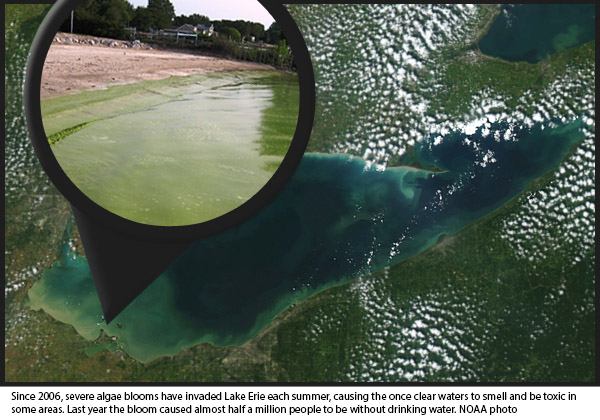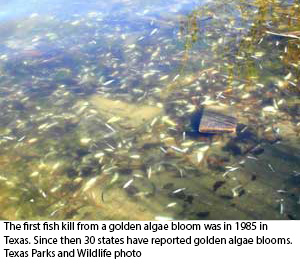
Earth Protect Blog
- Font size: Larger Smaller
- Hits: 2805
- 0 Comments
Clean water not green water
Last year at this time, the toxic algae bloom in Lake Erie caused nearly half a million people in and around Toledo, Ohio, to be without safe drinking water. Clean water from our taps is something that many of us take for granted, but if we don’t protect our water sources — like the residents of Toledo discovered — we won’t be able to take it for granted anymore.
Last year’s bloom was not a new occurrence in Lake Erie, and wasn’t even as bad as 2011’s record-breaking bloom, but it’s the first time on record the lake’s algae caused a Do-Not-Drink-the-Water advisory on that scale.
And the outlook for this year doesn’t look good either, as scientists from the National Oceanic at Atmospheric Administration predict this summer’s bloom “will be among the most severe in recent years.” And on Tuesday, Toledo’s mayor announced that microcystin was detected in Lake Erie near the city’s drinking water intake.
Microcystins are a type of toxin commonly found in algae blooms that can cause nausea, diarrhea, and vomiting, as well as liver damage in rare cases. Along with warming temperatures attributed to climate change that exacerbate the problem, algae blooms are often caused by the chemical process known as eutophication, or the oversupply of nutrients.
 The record-breaking bloom of 2011 in Lake Erie was the impetus for a detailed report that includes strategies on how to keep it from happening again, focusing on reducing nutrient pollution in the form of phosphorus into the lake. A task forcealso found that Lake Erie received the most phosphorus of any of the Great Lakes – nearly 50 percent of the total for all of the lakes, with two-thirds of that phosphorus from farm land.
The record-breaking bloom of 2011 in Lake Erie was the impetus for a detailed report that includes strategies on how to keep it from happening again, focusing on reducing nutrient pollution in the form of phosphorus into the lake. A task forcealso found that Lake Erie received the most phosphorus of any of the Great Lakes – nearly 50 percent of the total for all of the lakes, with two-thirds of that phosphorus from farm land.
The two reports also note that algal blooms were a massive problem in Lake Erie in the 60s and 70s, but were curtailed by reducing and regulating phosphorous use. That seemed to basically fix the problem with an occasional flair-up into the 80s and early 90s, only to reappear this decade worse than ever.
 Toxic algae blooms are not an isolated problem to Ohio.Whether its blue-green algae in Lake Erie or the recent phenomenon of golden algae blooms in Texas, algal blooms should be a concern for everyone that cares about clean water. Along with concerns over drinking water contamination, harmful algal blooms can also create “dead zones” that kill aquatic life, raise treatment costs for drinking water, and hurt businesses and jobs that depend on clean water.
Toxic algae blooms are not an isolated problem to Ohio.Whether its blue-green algae in Lake Erie or the recent phenomenon of golden algae blooms in Texas, algal blooms should be a concern for everyone that cares about clean water. Along with concerns over drinking water contamination, harmful algal blooms can also create “dead zones” that kill aquatic life, raise treatment costs for drinking water, and hurt businesses and jobs that depend on clean water.
It doesn’t take a scientist to realize that algal blooms can be tough on fishing and tourism. No one wants to swim, fish, or otherwise recreate in potentially toxic water that looks like pea soup, or around a bunch of rotting fish carcasses.
Ultimately though, the threat to clean drinking water is the primary concern, and increased incidents of blooms contaminating drinking water prompted the Environmental Protection Agency in May to issue “health advisories to protect Americans from algal toxins in drinking water.”
The EPA estimates that between 30 and 48 million people use drinking water from lakes and reservoirs that may be vulnerable to algae toxin contamination. “Nutrient pollution and harmful algal blooms are among America’s most serious and growing environmental challenges,” said EPA Administrator Gina McCarthy.
So how do we address this problem?
Clearly, we need stronger laws to crack down on pollution runoff from factory farms, and we also need to curb the carbon pollution that’s causing climate change. The new Clean Water Rule is also a large part of the solution, as it restores protections to wetlands that help filter runoff pollutants from rivers and streams before they get to our drinking water sources, like Lake Erie.
 The Clean Water Rule is under heavy attack in Congress. If you haven’t yet voiced your support for this common-sense, science-based plan to protect our drinking water, please do so today. Algae blooms can have a silver lining if we are willing to take the actions needed to keep them from getting worse. In many cases, we know what those solutions are, we just need the will to enact them.
The Clean Water Rule is under heavy attack in Congress. If you haven’t yet voiced your support for this common-sense, science-based plan to protect our drinking water, please do so today. Algae blooms can have a silver lining if we are willing to take the actions needed to keep them from getting worse. In many cases, we know what those solutions are, we just need the will to enact them.
Comments
-
Please login first in order for you to submit comments













